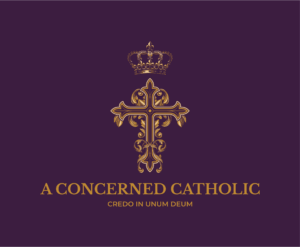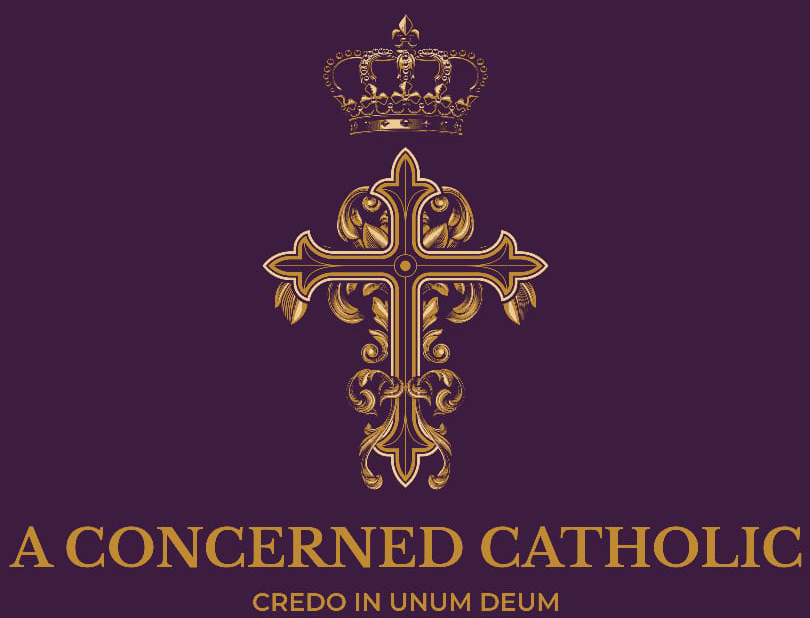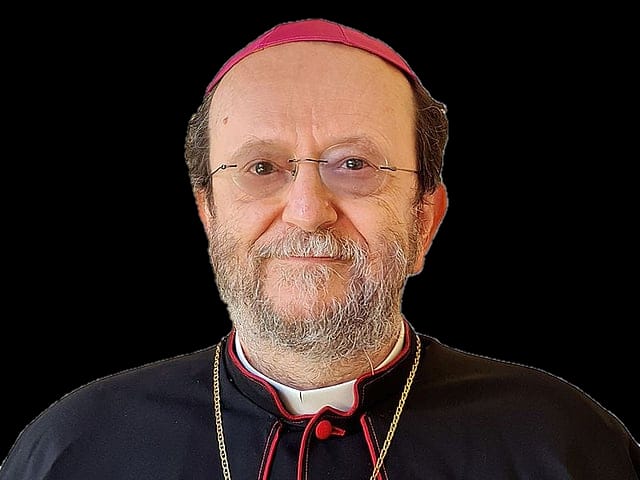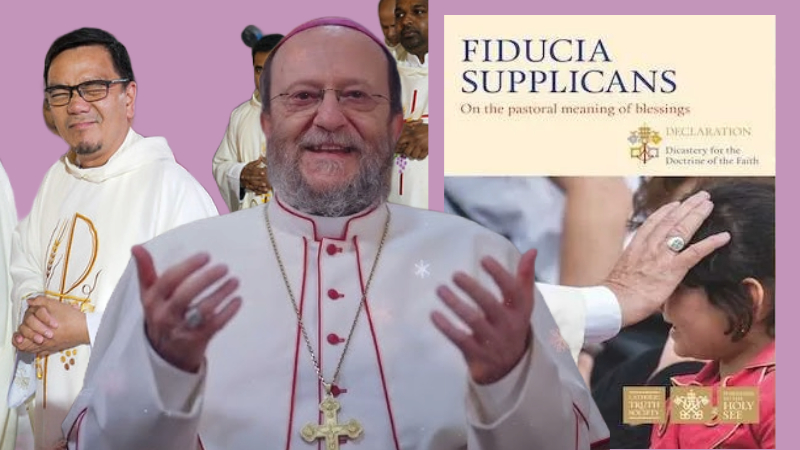Summary: A few observations on Mike Lewis, his obsession with the TLM, schismatics, and the Ordinary Magisterium.
Background
“Straight Answers…” is a bit of an elephant-hurl, listing 23 odd points on why he believes the TLM is not to be permitted – some which I have not even heard of – most have entirely nothing to do with the TLM (take for example, he mentions Young Earth Creationism and Geocentrism in this list; I wonder what this has to do with the TLM). I may come back to some of these points at a later stage, however in this blog I hope to address the primary concerns that Lewis has.
Totalitarian warnings
“Church leaders are concerned that many who belong to Latin Mass communities — including virtually all of their public spokespeople — openly reject the Second Vatican Council in whole or in part, do not respect the authority of the ordinary Magisterium of postconciliar popes, and question the legitimacy of the reformed liturgy. This is not just a rumor. Church leadership is truly concerned about these things.”
It is difficult to read this summary without laughing just a wee bit. Not because Lewis is right or wrong. But because of the totalitarianism Lewis tries to spin into his reprimand, which is the equivalent of ‘you-better-stop-it-or else’. Lewis acts as though Tradition is an overnight phenomenon. Hardly. Trads have been abandoned since the conclusion of Vatican II, and matters came to a head since Abp. Lefebvre’s consecrations, after which Ratzinger and Pope John Paul II unleashed their own version of home-bred TLM in the form of Ecclesia Dei, followed by relaxations to the TLM in Summorum Pontificum. Francis revoking the TLM in entirety through Traditionis Custodes was a new chapter in the persecution of the ancient rite. Again all of this was very Orwellian-Big-Brother-isque.

The ‘extreme’ crime according to Pope Francis? Worshipping God in a rite that was “…never abrogated” (refer Article 1 of Summorum Pontificum).
Apart from this, the Vatican apparatus has tried several coercive, arm twisting remedies, most of which have revolved around suspensions, and excommunications. Lewis cites most of the names of the ‘guilty’ offenders (Bp Strickland, Cardinal Burke, Fr. Altman, & Abp Viganò) with hopes to quell what he calls a ‘movement’ and follows this up with this ‘double-dare-you’ challenge or prophecy:
This polarization cannot continue indefinitely, can it? Assuming it does end, there are two possible outcomes: unity or full-blown schism. I would like to avoid schism if at all possible. But unity will not be easy to achieve.
But Trads have made themselves clear on the correct unity desired on several occasions. For example, the SSPX have had several discussions with Rome. Abp. Lefebvre, Bishop Fellay, and Bishop Tissier all have made statements that have made it clear that the only unity that is acceptable, is one where Rome returns to Tradition, not the other way around.
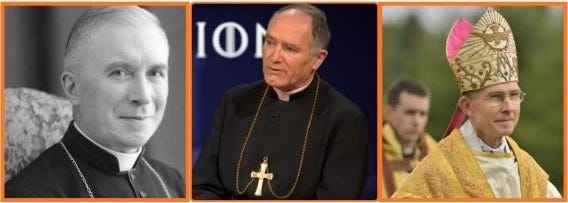
Trads, especially among those who prefer the Diocesan version of the TLM without the need to controversially quibble with Rome on Vatican II default-settings, were quite happy with the way things were going under Popes John Paul II and Benedict XVI. Being rather synodaly-numb, they continued like frogs in cold water, the heat to which was slowly but surely being turned up by the Vatican. But Lewis does not spare even these docile lambs: “Unity or Full-Blown Schism”, he warns them. Admonishing their half-measured approach, Lewis warns these Catholics of the ultimate stigma: Schism.
The ‘schismatic’ label is a tactic by hyper-papists such as Lewis to shut down questions or valid objections against the Pope.
Schism or Fidelity?
“There is a loud contingent of Catholics in the US who have promoted (and normalized) the false view that these teachings should be rejected or can be twisted in such a way to make them meaningless.”
From Cardinal Burke to Dr. Ralph Martin, many were eminent theologians. So what was the problem? This brings us to the question: What exactly is ‘the True Faith’? And what is the role of the Pope, for that matter?
Fidelity to the Depositum Fidei
The Tradition (capital ‘T’) that is always needed to be upheld by the entirety of Catholicism is the Deposit of Faith (Depositum Fidei. Refer 1 Tim 6:20, 2 Thess 2:15, Gal 1:8, Jude 3)
The fidelity of the pontiff is always to this Depositum Fidei. Refer the First Vatican Council document ‘Pastor Aeternus’ (section 6) which states:
“For the Holy Spirit was not promised to the successors of Peter so that they might, by His revelation, make known some new doctrine, but that, by His assistance, they might religiously guard and faithfully expound the revelation delivered through the Apostles” (emphasis mine)
From this definition, it is clear that
- The Pope is expected to guard the Depositum Fidei and preserve it from error.
- The Pope is also expected to ensure that teachings are in accordance with this Depositum Fidei, not the other way around.
- Only the aspects, that correspond to the Depositum Fidei, are to be considered as universally binding on Catholics.
- Moreover as per this definition, it becomes clear that no new doctrines, or teachings are to be introduced unless they are clearly having precedent and continuity in revelation and pre-conciliar teachings.
It is notable that Lewis does not mention fidelity to the Deposit of Faith in his blogs/articles that I linked, not even in passing. His views are therefore seemingly a one-sided representation, meant to continually scare or bully people into silence & submission by talking about just one facet of Catholic fidelity: i.e, fidelity to the pontiff; However the fidelity that should be regarded even above the submission to the pontiff, is fidelity to the Deposit of the Faith, to which even the pontiff is supposed to be subservient and at the service of.
Submission of “will and intellect” to the Ordinary Magisterium
Lewis often resorts to defending his hyper-papist position by cleverly appealing to the Ordinary Magisterium. He perhaps does this by sensing the talking points of the SSPX, who defend the consecrations by Abp Lefebvre by invoking:
(1) the argument from necessity – that unprecedented modernism & politics on the part of Rome had necessitated the consecrations of Bishops by the Archbishop without approval from Rome in order for the salvation of souls, &
(2) that Vatican II was a pastoral Council which did not produce teachings or dogmas that needed a Catholic to be bound to them.
The above iron-clad arguments allowed the SSPX to justify their position against Rome. And in order to bypass the SSPX talking points, Lewis resorts to Canon Law which in Canon 1323.1 states:
“§ 1. All of those things are to be believed with a divine and Catholic faith that are contained in the written word of God or in tradition and that the Church proposes as worthy of belief, as divinely revealed, whether by solemn judgment or by her ordinary and universal magisterium.” (emphasis mine).
Thus, those who dissent against the Roman Pontiff AND those who didn’t fall in line with even the Ordinary Magisterium seemed to be incurring the penalties spelled out in Canon Law. This, in Lewis’s mind applies to Conservative or Trads that dare to rise against the Pope and the Ordinary Magisterium.
Understanding the Ordinary Magisterium
And is Canon 1323.1 actually referring to Trads? In the context of dissent objected to by Lewis, does Canon Law 1323.1 & 750 along with the penalties ascribed in 1371 by Ratzinger and John Paul II apply to those whom Lewis names in his article?
George Weigel (who was the biographer of Pope John Paul II) in his 2002 book “The Courage to be Catholic” provides us with a interesting perspective, writing much before Lewis’s judgements.
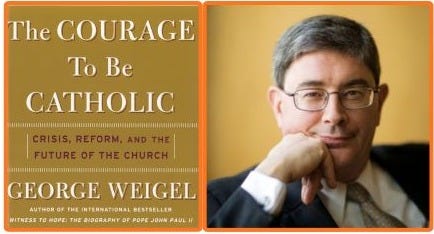
Speaking about the American Catholic Church after Vatican II, Weigel in his book (Chapter 3: How the Crisis happened) had a lot to say about the “dissent” which became evident among the clergy in two incidents following Vatican II. The first was after Humanae Vitae, the encyclical by Pope Paul VI (Ordinary Magisterium), where there was immense dissent & backlash by theologians, priests, nuns. Weigel describes this as follows:
“The public controversy over Pope Paul VI’s encyclical, Humanae Vitae, was perhaps the crucial moment in the formation of a culture of dissent that would influence the Catholic Church in the United States for the rest of the twentieth century.” (page 68)
And
“Theologians, priests, and religious men and women under vows of obedience, could in effect, throw a papal encyclical, a solemn act of the Church’s teaching authority, back in the Pope’s face – and do so with impunity. The culture of dissent, professional division, was born.”….“It was possible to pick and choose among those teachings that seemed most congenial, given one’s circumstances and preferences. Thus “Cafeteria Catholicism” was another child of the Humanae Vitae controversy…” (page 71 & 72)
Weigel mentions a second episode which involved a study of Catholic sexual ethics commissioned in the wake of Humanae Vitae by the Catholic Theological Society of America (CTSA), demonstrating how the culture of dissent had taken hold by the early 1970s. As per Weigel :
“The study, (titled) “Human Sexuality: New Direction in American Catholic Thought” advocated a dramatic shift in the framework within which Catholic moral theologians thought about questions of sexual morality …Both the study’s theological conclusions and the guidelines flatly challenged longstanding Catholic teaching on virtually every issue of sexual morality, including contraception, masturbation, and homosexuality.” (page 73)
Continuing to write on “Human Sexuality…Catholic Thought” Weigel states that (emphasis mine):
“To be a witness to the fullness of Catholic faith now seemed antiquated, even bizarre. Orthodoxy, not heterodoxy, became suspect. Men who held firmly to the Church’s authoritative teaching came to be seen as “rigid” or “ideological,” and their own maturity and stability were questioned.”
What? Men who held firmly to the Church’s perennial teachings were seen as “rigid”? Where have we heard that word used recently?
Weigel follows this with:
“That is what too many seminarians and priests did in the quarter-century following the Second Vatican Council. They fell out of full communion with the Church, whether the issue at hand was contraception, abortion, homosexuality, or the possible ordination of women to the priesthood” (emphasis mine).
So clearly, the dissent summarized by Weigel in 2002 when he wrote “The Courage to be Catholic…” was referring to a rebellious, heresy-like dissent by many within the Catholic Church, which he also referred to as “the invisible schism”. It is to such dissent which is against the constant teachings of the Catholic Church that one should be concerned about. And rightly so, it was with this backdrop that Cardinal Ratzinger (the then prefect of the CDF) and Pope John Paul II in 1998 had therefore introduced revisions to the code of Canon Law – not against faithful & devout Conservatives or Trads.
Now fast forward to Pope Francis and his ‘Ordinary Magisterial’ teachings on Amoris Laetitia in 2016, and Fiducia Supplicans in 2023. Exactly what Weigel described in 2002, took place, viz: (1) Being a witness to the fullness of Catholic faith became antiquated and ‘rigid’. (2) Heterodoxy, not Orthodoxy, was championed, & (3) People who held firmly to the Church’s authoritative teaching came to be seen as unstable, and ideological.
And it is with this background that Mike Lewis complains that Catholics have begun:
“Claiming that official teachings — such as Amoris Laetitia, Fiducia Supplicans, or the revision to the Catechism on the death penalty — are doctrinally erroneous or incompatible with tradition.”
Conclusion
However, when successive Popes abandon the Depositum Fidei, it is incumbent upon the faithful to object even if they are labelled ‘schismatics’ remembering that in the final analysis, our allegiance is to the Depositum Fidei first and foremost. Then to the Pope. And we must stand our ground to whatever persecution is hurled at us in our firm unremitting stance remembering what it is that we are fighting for.
Ave Maria
